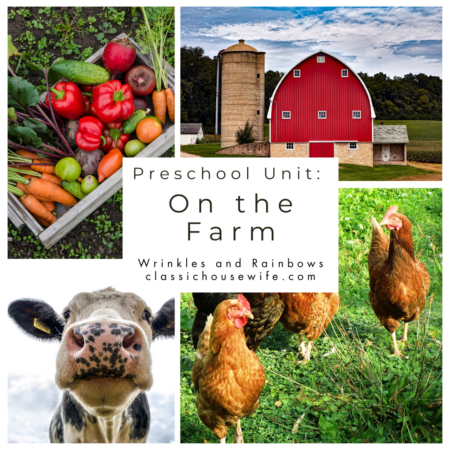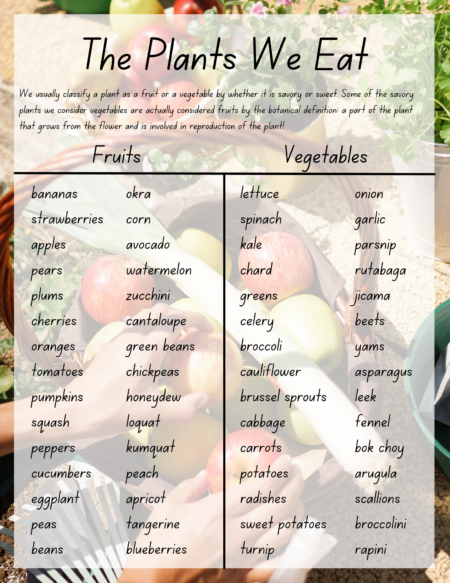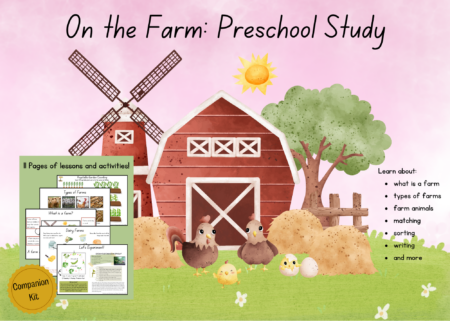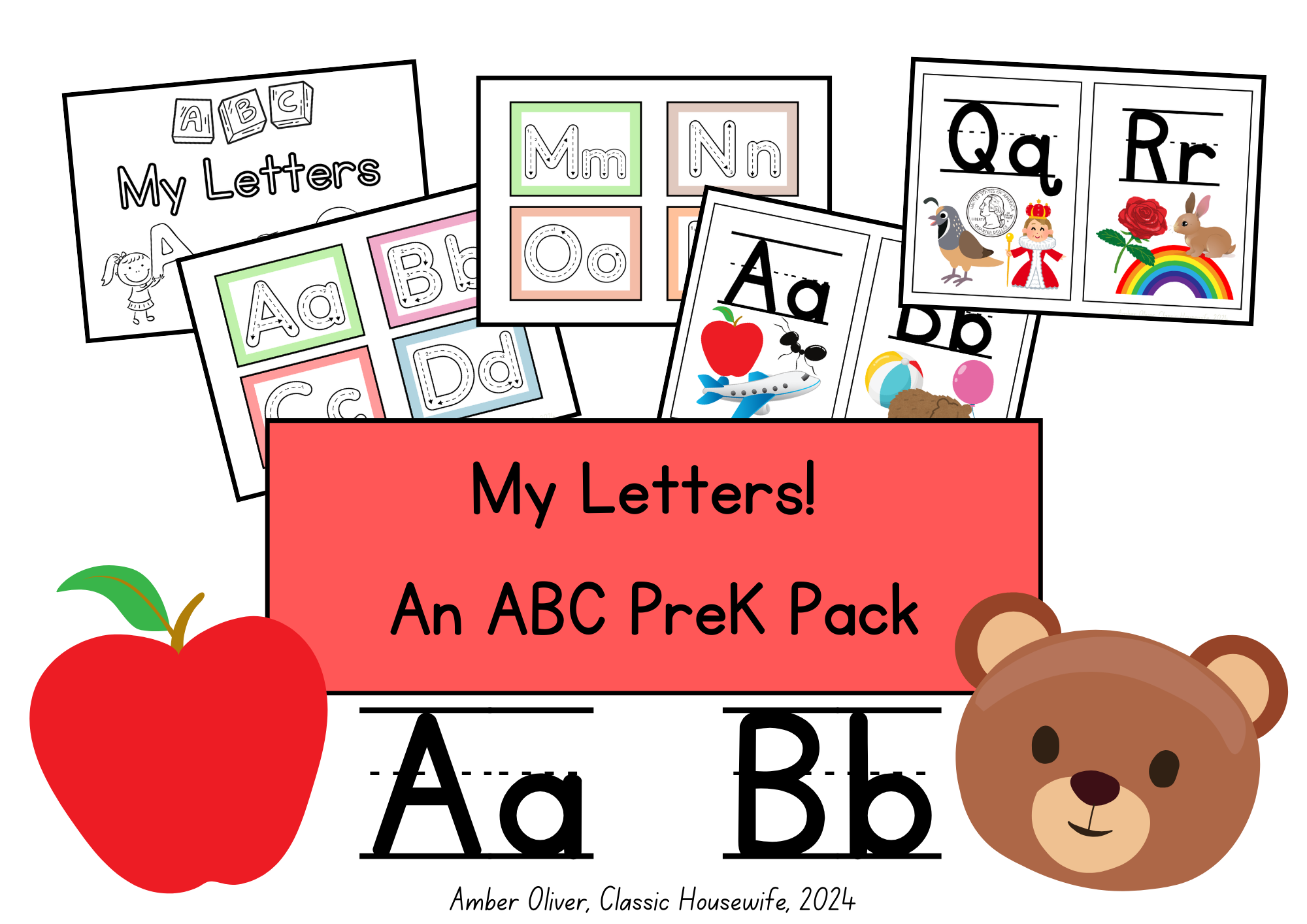Preschoolers love learning about farms! Doing a preschool farm study is a great way to introduce them to some new things outside of their small world. Unless you live on a farm, most four year olds haven’t seen cows and pigs and goats in real life. Also, most kids like animals and baby animals so it’s a win-win. =)
“On the Farm” is the second study we are doing for our preschool year. We have several friends with small farms and Lil Miss Mouse adores baby goats, feeding animals, and gardening. This month we will be digging a little deeper and learning a little more.

What is a farm?
First order of business is defining a farm. The simplest definition is this: an area of land used for growing animals or crops.
Farms can be small, run by one person or family, or very large businesses with lots of employees. Farms come in many shapes and sizes. In this unit we will look at some of them.
- Read: “Farming” by Gail Gibbons.
- Read: Chapter One “The Anatomy of a Farm” in “Farm Anatomy Activities for Kids: Fun, Hands-On Learning” by Dawn Alexander MS
- Set up a farm themed invitation or sensory bin to play with (check out this farm sensory kit.)
Some Types of farms:
Meat and dairy farms grow animals to eat their meat or their milk, such as cows, goats, chickens, pigs, ducks, and turkeys. Milk also is used to make cheese and yogurt.
Crop farms grow fruits, vegetables or grains to harvest and eat, such as corn, wheat, carrots, beans, strawberries, or pumpkins. Grains like wheat and corn can eaten whole or ground into flour to make bread.
Livestock farms raise livestock for their resources or labor. Alpaca and sheep wool can be sold to make yarn for making blankets and clothes. Horses and donkeys can be sold as work animals.
Orchards and tree farms grow trees like apple trees or Christmas trees. Fruit trees like apple, orange, pear, and plum trees take a long time to grow and produce a lot of fruit.
Bee farms are called apiaries. Some people have very large bee farms that produce very large amounts of honey and beeswax. A lot of small farms also have small bee farms called hives.
Some farms grown one thing, like fish farms, flower farms, and peanut farms. A lot of farms have many different types of things they grow, and family farms often make and sell their own products.
- Read “The Big Red Barn” by Margaret Wise Brown
- Watch “Field trip to the Farm” on YouTube.
- Plan a trip to a local farm or two.
- Find a place to buy farm fresh eggs or local honey.
Types of farming equipment.
All farms need some type of farm equipment and tools. Small farms use smaller tools but they still need something to dig up the ground or harvest it, something to haul supplies, and tools to take care of the animals. When we think of farm equipment, we usually think of the big ones. =) Some of the most common items are:
- Tractor
- Wagon
- Plough
- Harvester
- Wheelbarrow
- Shovel
- Rake
- Hoe
- Pitchfork
But if you have a kid who really loves big trucks and tractors and all sorts of large machinery, then you can use this list of 20 pieces of farm equipment (with pictures and uses.)
- Read “John Deere Around the Farm Explore & Find” by Jack Redwing
- Print and color some “Farm Tool Coloring Pages“
- Check out this sensory bin kit with farm tools.
- Design and Build a Tractor, in “Farm Anatomy Activities for Kids: Fun, Hands-On Learning” by Dawn Alexander MS
Farm animals
Livestock farms, dairy farms, and meat farms will have LOTS of animals. They grow lots and lots of animals to make lots and lots of milk, wool or meat to sell. But they might only have one type of animal on their farm.
Produce farms may not have any animals at all, although some produce farms also like to have bee hives to help with pollination. Family farms will probably have many different animals and crops. One farm could have cows, horses, goats, sheep, pigs, rabbits, chickens, ducks, geese, and turkeys!
The animals you’ll find on the farm depends on the farm you visit!
- Make this paper barn craft.
- Read: Chapter Five “Meet the Farm Animals” in “Farm Anatomy Activities for Kids: Fun, Hands-On Learning” by Dawn Alexander MS
- Find and visit a farm animal petting zoo.
Vegetables and Fruits
Did you know that we tend to identify fruits and vegetables by whether or not they are sweet or savory? But there is a botanical definition for “fruit” that actually makes some our favorite veggies classify as fruits!
Botanically speaking, a fruit is produced from a flower and plays a role in the plant’s reproduction, whereas a vegetable can be any part of a plant and does not. This means that our savory squashes and beans are technically FRUIT – at least as far as plant botany is concerned. For the purpose of this lesson, since we will use the botanical definition, and when we are cooking, we can use the culinary definitions. =)

- Read: Chapter Four “Know Your Crops” in “Farm Anatomy Activities for Kids: Fun, Hands-On Learning” by Dawn Alexander MS
- Find and visit a farmer’s market, buy some produce.
- Make a salad using a large variety of fruits and vegetables.
- Read: “From Seed to Plant” by Gail Gibbons
- Plant a bean and watch it grow.
Dairy Products
Dairy products are all things that are made from milk. These can be made from cow milk, goat milk, or any type of milk. Milk, cream, butter, cheese, yogurt, and cottage cheese are all dairy products.
Did you know that you can make your own cheese, butter, yogurt, and cottage cheese at home? Using raw milk is best but you can use pasteurized milk from the grocery store, too! Milk has healthy fats, vitamins, and protein for our bodies.
- Visit a dairy farm, buy some milk
- Make homemade yogurt in your crockpot.
- Make butter by shaking cream in a jar.
Meat products
Some young kids don’t know which types of meat come from which types of animals. And some don’t realize the meat at the store comes from animals at all! Take a trip to the meat section at the grocery store or a butcher shop and talk about the different types of meat you can buy.
- Chicken – chicken breasts, drumsticks, chicken lunch meat, canned chicken, chicken tenders, chicken nuggets (and eggs)
- Cow- ground beef, beef steaks, beef roasts, brisket, hamburgers,
- Pig – ham, bacon, pork chops, ground pork, pork sausage
- Turkey- turkey breast, turkey drumsticks, turkey lunch meat, Thanksgiving turkeys
Activity: Make playdough turkey legs, hamburgers, chicken nuggets and more, while discussing what meats come from which animals. (Use the poster in my farm kit for reference. See below.)
Farm to Table:
There are many ways of getting food from the farm to your table. The most important thing to remember is that everything comes from a farm, big or small, and without farms we wouldn’t have food! Farming is hard and dirty but it’s very important work. If you have a small garden or farm in your yard, you’re doing important work, too!
Ways food gets from the farm to our table:
- 1- you grow it and eat it!
- 2- farmers markets – farmers sell the things they grow and make
- 3- small local markets and shops (like butcher shops) make these products available to buy
- 4- at the farm, like you pick farms, raw milk farms, etc – you go to the farm to buy the food
- 5- big farms sell and ship to big grocery stores like Walmart and Brookshire’s – you buy the food from the grocery store.
How many different ways have you gotten food from a farm? Can you try a new way like visiting a you pick farm or a butcher shop?
- Read: Chapter Six “From the Farm to Your Home” in “Farm Anatomy Activities for Kids: Fun, Hands-On Learning” by Dawn Alexander MS
- Research and a make a list of small local farms and farmers in your area. Who can you buy eggs, milk, or honey from? Who sells farm grown chicken and beef? When and where does the farmer’s market meet? Pick one, visit, shop, and support your local farmers.
On the Farm Preschool Unit Study
I have a companion study kit in the shop that goes along with this unit study. In this kit you’ll find some printable posters, some worksheets, some activities, and some recipes.

On the Farm Preschool Study Companion Set
11 pages of posters, worksheets, and activities.
$3.99
Included in the kit:
- “What is a Farm” poster
- “Types of Farms” poster
- Dairy farm activity sheet
- Fruit or vegetable sorting activity
- Mommy/Baby animal matching (learn the names of farm animal babies)
- “The Animals We Eat” poster
- Chicken sorting by size activity, cutting activity
- Vegetable garden counting worksheet
- Farm word tracing worksheet
- Bean sprouting experiment activity
- Making butter and buttermilk pancakes activity
- Tips and suggestions page

